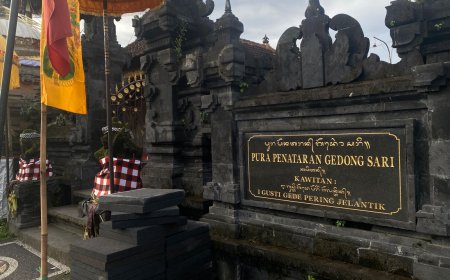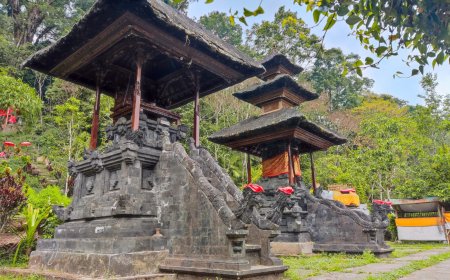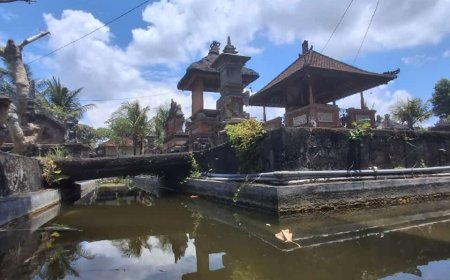Puri Agung Carangsari: Shri Arya Sentong's Journey to Find the Center of Bali
The term "Kawitan" in the Hindu tradition of Bali refers to the worship of ancestors from the same lineage, and Pura Kawitan serves as the main place for honoring these ancestors. One prominent lineage is that of the Arya, exemplified by Shri Arya Sentong, with its central Kawitan located in Puri Agung Carangsari, Petang District, Badung Regency, Bali. To this day, Puri Agung Carangsari remains the focal point of worship for the descendants of Shri Arya Sentong throughout Bali.

The Balinese Hindus recognize the term "Kawitan." Kawitan is derived from the word "wit," which means lineage. Kawitan holds the meaning of worshiping the ancestral spirits from the same lineage. With the existence of the term Kawitan, there is also the concept of "Pura Kawitan." Pura Kawitan serves as a place to worship the ancestors from the same lineage. Therefore, each lineage has its own Kawitan. The term Kawitan became known during the era of the Kingdoms in Bali, based on inscriptions left by several Balinese kings.
One of the lineages in Bali is the lineage of the Arya. Historically, the title Arya was given to the warrior class. As time progressed, the title Arya was translated into "Gusti" in Bali. One notable figure among the Arya is Arya Sentong, also known as Shri Arya Sentong. The descendants of Shri Arya Sentong have several Pura Kawitan. However, the central place for the Kawitan of the descendants of Shri Arya Sentong is located at Puri Agung Carang Sari, Petang District, Badung Regency, Bali.
Shri Arya Sentong first arrived in Bali in the 11th century. During the Gelgel Kingdom, he participated in the construction of Pura Besakih, also known as Pura Basukian at that time. Shri Arya Sentong had a son named Shri Arya Pacung. When his son turned 6 years old, Shri Arya Sentong assigned him a task to go to Nusa Penida. During that time, Bali was in a critical situation. Ida Bhatara Kala came every day to seek victims, causing fear among the Balinese people.
Shri Arya Sentong then negotiated with Ida Bhatara Kala, requesting him not to come to Bali too frequently. This request was agreed upon by Ida Bhatara Kala with one condition: Shri Arya Sentong had to find the center of Bali to protect the island. Ida Bhatara Kala also bestowed a gift, his fang transformed into a keris. This keris became known as the Keris Ki Ulang-Ulang Guguh. The keris came with a prohibition—if drawn, the bearer must not retreat or surrender to the opponent but must continue to advance.
Shri Arya Sentong resided in Nusa Penida for approximately 30 years. When Shri Arya Pacung reached adulthood, the mandate to find the center of Bali was passed on to him. At that time, Shri Arya Pacung was married and had a son named I Gusti Ngurah Putu Pacung. Equipped with the Keris Ki Ulang-Ulang Guguh, Shri Arya Pacung then took over his father's role in searching for the center of Bali. Shri Arya Sentong later achieved moksa (spiritual liberation) in Nusa Penida.
Shri Arya Pacung was initially confused about how to find the center of Bali. He then sought help from his mother, Ratu Mas Maketel. When Shri Arya Pacung held his mother's hand, the entire Bali region instantly illuminated, revealing the directions of the compass. These compass directions are now known as Dewata Nawa Sanga. He then embarked on a journey to find the centre of Bali.
During his journey, Shri Arya Pacung was confronted by the forces of I Gusti Ngurah Jelantik in the Gianyar region. At that time, Shri Arya Pacung was asked to step aside, but he refused. This led to a skirmish between the two forces. Armed with the Keris Ki Ulang-Ulang Guguh, Shri Arya Pacung fought against I Gusti Ngurah Jelantik. However, since both were equally strong, the confrontation resulted in exhaustion without a clear winner.
This confusion led both of them to inquire about Shri Arya Pacung's identity. When revealed, it turned out that they were still family. Therefore, they agreed to make peace and exchanged their respective waistbands (saput). Shri Arya Pacung wore I Gusti Ngurah Jelantik's black-and-white waistband (Saput Poleng), while I Gusti Ngurah Jelantik wore Shri Arya Pacung's white Saput. Afterward, Shri Arya Pacung chose to continue his journey.

Merajan Agung Puri Carangsari (Sourse: Personal Collection)
Shri Arya Pacung's journey continued to a cool, lush, and beautiful area with a clear river. He felt a sense of peace there. Due to his fondness for the area, he named it Perean or Perariyan. He also established Puri Perean and was later appointed as the King of Perean. His son, I Gusti Ngurah Putu Pacung, then succeeded him as the King of Puri Perean.
I Gusti Ngurah Putu Pacung had three children. His eldest son was named I Gusti Ngurah Gede Pacung, who later was crowned as the King of Perean. I Gusti Ngurah Gede Pacung got married and had a son named I Gusti Ngurah Raka Pacung. I Gusti Ngurah Raka Pacung succeeded his father in leading Puri Perean. He, in turn, had a son named I Gusti Ngurah Pacung Sakti, who also became the King of Perean.
Long story short, a dispute among family members led to the demise of I Gusti Ngurah Pacung Sakti. His body, known as Layon, was then buried. However, a miraculous event occurred. On that night, the grave exploded, revealing I Gusti Ngurah Pacung Sakti flying using the Geringsing Wayang cloth, riding a Naga Kahang (dragon). The figure of I Gusti Ngurah Pacung Sakti then disappeared and merged with Brahman or attained Moksa.

Shrine Adorned with Naga Kahang Ornaments (Source: Perosnal Collection)
Due to the death of I Gusti Ngurah Pacung Sakti, the situation in Puri Perean became chaotic. The descendants of I Gusti Ngurah Pacung Sakti left Perean, including I Gusti Ngurah Pacung Gede. He, accompanied by 400 families, moved to Pahyangan and became the King there. Later, he adopted a child who became known as I Gusti Ngurah Pacung Gede Oka.
In the 14th century, I Gusti Ngurah Pacung Gede arrived in a wilderness that already had three villages within it: Desa Bebalang, Desa Telugtug, and Alas Wayah. I Gusti Ngurah Pacung Gede Oka stepped into Alas Wayah due to unrest in Puri Pahyangan, where the Prime Minister of Puri Pahyangan sought to seize power. Therefore, I Gusti Ngurah Pacung Gede Oka and his followers chose to seek refuge.
His arrival in Alas Wayah reached the ears of the leaders (mekel) of the neighboring villages. Subsequently, the leaders of Desa Telugtug and Desa Alas Wayah pleaded with I Gusti Ngurah Pacung Gede Oka to stay, build a puri, and lead their territory. This request was granted by I Gusti Ngurah Pacung Gede Oka, with the condition that the puri to be built would be located in the center of the three areas. Since then, Puri Agung Carangsari was constructed.
Puri Agung Carangsari was built in 1384. Its location in the center of Bali aligns with the command of Ida Bhatara Kala. This is also the reason why Puri Carangsari became the center of worship for the descendants of Shri Arya Sentong throughout Bali. The Keris Ki Ulang-Ulang Guguh then attracted the scattered descendants of Shri Arya Sentong from all over Bali. "Carangsari" means that a leader must always be in the midst of the community and act as a mediator in all issues with wisdom. With the residence of I Gusti Ngurah Pacung Gede Oka in Carangsari, leadership in Pahyangan was handed over to his adopted son. In recognition of the greatness of Shri Arya Sentong, he was given the title Ksatryaning Dalem Amangkubumi Shri Arya Sentong.






























































